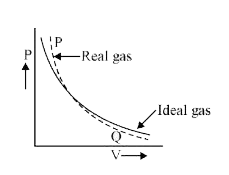Maximum deviation from ideal gas is expected from
N2(g)
CH4(g)
NH3(g)
H2(g)
Step by step video & image solution for Maximum deviation from ideal gas is expected from by Chemistry experts to help you in doubts & scoring excellent marks in Class 12 exams.
Updated on:21/07/2023Topper's Solved these Questions
- STATES OF MATTERBOOK - AAKASH INSTITUTE ENGLISHCHAPTER - STATES OF MATTEREXERCISE - ASSIGNMENT (SECTION-D)
14 Videos
- STATES OF MATTERBOOK - AAKASH INSTITUTE ENGLISHCHAPTER - STATES OF MATTEREXERCISE - ASSIGNMENT (SECTION-B)
34 Videos
- SOME BASIC CONCEPTS OF CHEMISTRY BOOK - AAKASH INSTITUTE ENGLISHCHAPTER - SOME BASIC CONCEPTS OF CHEMISTRY EXERCISE - ASSIGNMENT SECTION J (Aakash Challenges Questions)
10 Videos
- STRUCTURE OF ATOMBOOK - AAKASH INSTITUTE ENGLISHCHAPTER - STRUCTURE OF ATOMEXERCISE - ASSIGNMENT (SECTION -D) Assertion-Reason Type Questions
15 Videos
Similar Questions
Knowledge Check
Under what conditions to gases show maximum deviations from ideal gas behaviour ?
AAt high temperature and low pressureBAt low temperature and high pressureCAt high temperature and high pressureDAt low temperature and low pressure
At which one of the following temperature pressure conditions, the deviation of a gas from ideal behavior is expected to be minimum?
View SolutionThe gases obey the different gas laws only theoretically. Practically all of them show some deviation from these laws. These are called real gases. The deviation are maximum under high pressure and at low temperature. These are comparatively small when the conditions are reversed. It has been found that the easily liquefiable gases show more deviations from the ideal gas behaviour as compared to the gases which are liquified with difficulty.
Gas deviates from ideal gas behaviour because molecules
View SolutionThe gases obey the different gas laws only theoretically. Practically all of them show some deviation from these laws. These are called real gases. The deviation are maximum under high pressure and at low temperature. These are comparatively small when the conditions are reversed. It has been found that the easily liquefiable gases show more deviations from the ideal gas behaviour as compared to the gases which are liquified with difficulty.
The van der Waals equation reduces itself to ideal gas equation at
View SolutionThe gases obey the different gas laws only theoretically. Practically all of them show some deviation from these laws. These are called real gases. The deviation are maximum under high pressure and at low temperature. These are comparatively small when the conditions are reversed. It has been found that the easily liquefiable gases show more deviations from the ideal gas behaviour as compared to the gases which are liquified with difficulty.
The temperature at which the real gases obey the ideal gas laws over a wide range of pressure is called
View SolutionThe gases obey the different gas laws only theoretically. Practically all of them show some deviation from these laws. These are called real gases. The deviation are maximum under high pressure and at low temperature. These are comparatively small when the conditions are reversed. It has been found that the easily liquefiable gases show more deviations from the ideal gas behaviour as compared to the gases which are liquified with difficulty.
The compressibility factor for an ideal gas is :
View SolutionAt point P and Q, the real gas deviation with respect to ideal gas is respectively :

View SolutionGases like CO2 and CH4 show more deviation from the ideal gas behaviour as compared to gases like H2 and He, Explain
View Solution
